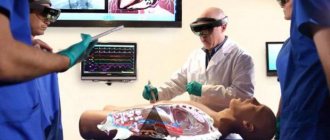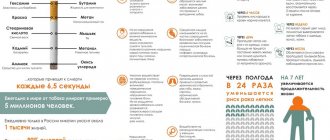Home — For the public
- Map of medical organizations
- Vaccination
- Clinical examination
- Fluorography
- Addresses and opening hours of clinics
- Emergency rooms
- Oncology
- Where to take an HIV test
- Healthy child's office
- Services
- Prevention of CVD
- Disease Prevention
- World Patient Safety Day
- Newspaper "Medical News"
- specialist
- School of Health
— Disease prevention
- HIV infection
- All about vaccination
- All about proper nutrition
- Hepatitis
- Flu
- Dementia
- Schoolchildren's health
- STD
- Tick-borne encephalitis
- Whooping cough
- Measles
- Legionellosis
- Meningococcal infection
- Oncology
- Acute intestinal infection
- Pediculosis
- First aid
- Pneumococcal infection
- Pneumonia
- Prevention of rabies
- Dependency Prevention
- Rotavirus infection
- Diabetes
- Cardiovascular diseases
- Injuries
- Tuberculosis
- Tularemia
- Physical activity
- Obstructive pulmonary disease
- Exotic infections
- Ecology
- Why is swimming in ponds dangerous?
— Prevention of addictions
- Prevention of alcoholism
- Smoking prevention
— Smoking prevention — Passive smoking, what is its danger
Smoking has become a tobacco epidemic both throughout the world and in our country. According to statistics, 60.7% of men and 21.7% of women in Russia are smokers, and a third of them are under 25 years of age. Everyone knows about the dangers of smoking, but few people think about whether passive smoking is dangerous?
Passive smoking is a condition when a non-smoker is forced to inhale air containing combustion products of tobacco from a smoker’s cigarettes.
Medical and social studies conducted in recent years have proven that smoking has a harmful effect on health not only on smokers themselves, but also on people who are nearby.
Composition of cigarette smoke
Several thousand harmful components have been found in the chemical composition of tobacco smoke, which have a toxic, carcinogenic and mutagenic effect on the body.
The main components of cigarette smoke:
- carbon monoxide or carbon monoxide;
- resin;
- nicotine;
- naphthalene;
- phenol, cresol;
- N-nitrosamines;
- aromatic hydrocarbons;
- argon;
- arsenic;
- methane;
- Nitric oxide;
- hydrocyanic acid;
- ammonia;
- hydrogen sulfide;
- pyrene, aldehyde;
- alcohol;
- inorganic compounds: lead, cadmium, nickel.
The most dangerous substances include:
- The alkaloid nicotine is a potent universal poison that destroys all organs and tissues of the body.
- Hydrocyanic acid (hydrogen cyanide) is a poison that affects the respiratory system.
- Arsenic is a toxic substance used in everyday life to poison rodents.
- Polonium is a radioactive substance that, when accumulated in the body, has a carcinogenic effect.
- Nickel is a metal that is toxic, leads to asthma, acts on the kidneys, and provokes the development of malignant tumors.
- Resin is an organic mineral that attacks lung tissue, causing cancer.
When tobacco is burned, 3 streams of smoke are formed:
- The main one is produced during a puff of smoke and is inhaled by the smoker.
- Sidestream is the smoke that comes from a smoldering cigarette between puffs.
- Smoke exhaled by a smoking person.
90% of the main flow consists of 350-500 gaseous components, of which carbon monoxide and carbon dioxide are considered especially dangerous. The rest is represented by solid microparticles with various toxic inclusions.
With passive smoking, air is inhaled mixed with the side stream of tobacco and with the smoke exhaled by the smoker.
Statistics
The numbers are dry. But sometimes they can say more than hundreds of words. Here are just a few statistical facts.
In the United States, more than 126 million nonsmokers are exposed to secondhand smoke.
Of these, 50 thousand people die every year from diseases associated with exposure to tobacco. Of this number, 3,000 people died from lung diseases (most often cancer and emphysema).
More than 60% of American children live with chronic second-hand smoke.
More than 40% of children who contact emergency services for asthma are passive smokers.
In the United States, more than $10 billion a year is spent on additional medical care, treatment, and diagnosis of diseases associated with secondhand smoke.
The UK Health Authority estimated that in 2011, more than 300 thousand children - passive smokers - went to medical institutions and 9,500 of them were hospitalized.
In Australia in 2005, it was estimated that 113 adults and 28 children died from illnesses caused by inhaling second-hand smoke at home.
The harm of passive smoking
Being in the same room with an active smoker for an hour, a non-smoker inhales a portion of tobacco smoke that is equivalent to smoking half a cigarette.
The harmful effects of passive inhalation of tobacco smoke are conventionally divided into 2 groups.
Immediate action is what a person feels immediately after being in a smoky room:
- Irritation of the mucous membranes of the nasopharynx, bronchi, eyes: sore throat, cough, lacrimation.
- Dry mouth.
- Effects of tobacco toxins on the central nervous system: headache, dizziness, nausea.
- Disorder of the cardiovascular system with symptoms of hypoxia: increased heart rate, shortness of breath, increased blood pressure due to a decrease in the oxygen content in the inhaled air.
- Allergic reactions to components of tobacco smoke.
Delayed, which develop over a long period of time:
- Pathologies of the bronchopulmonary system: asthma, bronchitis, emphysema.
- Chronic diseases of the ear, nose and throat.
- Diseases of the heart and blood vessels: early atherosclerosis, ischemic disorders, heart rhythm disturbances, hypertension.
- Allergic diseases.
- In children there is a delay in psychomotor development.
- Increased risk of malignant neoplasms.
- High percentage of disability and death.
According to American researchers, the delayed effects of passive smoking cause 46 thousand deaths per year, with 14 thousand deaths due to oncology, and 32 thousand due to heart and vascular diseases.
How to protect yourself from the harmful effects of cigarette smoke
“In my sister’s family, it’s common to smoke in the house. She herself does not smoke, but she is loyal to her husband’s habit, since in their house the man is considered the master. In her opinion, this is not recklessness, but respect for her husband. When I try to tell her with examples how harmful second-hand smoking causes, she just brushes it off. But he feels like a king and often says that it is not a king’s business to change his habits.”
— Elena, ecologist
The tips below will be useful for both passive and active smokers. It is important to understand that a bad habit is a problem for the whole family. General principles and support are important in solving it.
Let us help you quit smoking
BUY ] WATCH VIDEO ABOUT THE SERVICE[/anchor]
1. Home is not a place for smoking
Smoking in a separate room or on the balcony does not protect loved ones from exposure to harmful substances. The smoke will still spread to other rooms. The same rule is also relevant for smoking in the stairwell: the right to health of not only relatives, but also neighbors should be respected. By the way, this is prohibited by law. You have every right to ask your guests and friends to abide by this rule.
2. Do not smoke in the car. The interior trim absorbs tobacco smoke. Smoking with the windows open while driving will not help the situation: air currents will carry smoke back into the cabin.
3. Stay away from smoking rooms When in public places, choose smoking-free areas. When going to the airport or train station, check in advance where the smoking areas are located and plan a route to avoid them. In restaurants and bars, be seated in non-smoking areas. 4. Train healthy breathing Try to walk in parks, squares, and near ponds as often as possible. If possible, go for bike rides, do breathing exercises, and swimming.
The effect of passive smoking on the respiratory system
Constant irritation of the respiratory tract mucosa by tobacco smoke leads to the formation of chronic rhinitis, pharyngitis, and bronchitis. Bronchial asthma develops with passive smoking 5 times more often than in people protected from tobacco smoke.
Problems with nasal breathing cause inflammation of the Eustachian tube, which connects the mouth to the ear. As a result, frequent otitis media and hearing loss are observed.
Radioactive isotopes of tobacco smoke, recognized as the strongest carcinogens, when entering the lung tissue, cause metaplasia of alveolar cells with the formation of malignant tumors.
Prohibited by law
Smoking in public places, including children's playgrounds, is already prohibited by law.
The law will come into full force only from June 1, 2014. The ban also applies to hotels, sanatoriums and resorts, medical and educational institutions, all public transport, retail outlets, social services and other places of public use, so that a qualitative improvement in the life and health of people who do not want to become involuntary smokers is expected soon. Tags:
- Passive smoking
central nervous system
In addition to the alkaloid nicotine, which has a neurotoxic effect, tobacco smoke contains many other poisonous and toxic substances (carbon monoxide, phenol, ammonia) that damage various structures of the brain.
The results of the impacts are:
- Psycho-emotional disorders, rapid mood swings: agitation, apathy
- Sleep disorder: insomnia, daytime sleepiness.
- Change in taste sensations.
- Loss of appetite, nausea.
- Headaches, dizziness.
- Weakness, increased fatigue.
- Decreased brain function: absent-mindedness, forgetfulness, memory impairment.
Heart, blood vessels
Under the influence of toxic substances from tobacco smoke, a pronounced dysfunction of the cardiovascular system develops. This contributes to the development of early atherosclerosis, angina pectoris, hypertension, which ultimately provokes heart attacks and strokes.
Carbon monoxide formed during the combustion of tobacco, entering the blood, reduces the ability of red blood cells to deliver oxygen to the cells of the body, leading to thrombus formation. Blockage of arteries with blood clots causes heart damage (infarction) and circulatory disorders in the lower extremities (obliterating endarteritis).
If you already have cardiovascular disease, even short-term exposure to tobacco smoke can lead to severe attacks of angina.
Effect of secondhand smoke on children
One of the proofs of the harmful effects of passive smoking on children is the fact that in families where one or both parents smoke, the child’s incidence of respiratory diseases, bronchitis, and pneumonia increases several times. Smoke components penetrate into the breast milk of a nursing mother, that is, gradual poisoning of the child occurs, the consequence of which is depression or stimulation of the central nervous system: the child is inhibited, lethargic, sleeps a lot, or, conversely, screams, cries, eats poorly, regurgitates, does not gain weight.
The formation of minimal brain dysfunctions, which are manifested by delayed speech development and fine motor skills, which subsequently causes problems with assimilation of educational material, poor adaptation in a team, and behavioral characteristics at school. Increased susceptibility to allergic diseases: atopic dermatitis, bronchial asthma.
Long-term consequences of nicotine intoxication in a child: increased risk of developing diabetes, obesity, autism, cardiovascular diseases, hypertension.
Since the child’s body is in the stage of active growth and development, its cells are more susceptible to mutations due to the action of tobacco toxins.
The effect of electronic cigarettes on passive smokers
It is believed that smoking electronic devices, unlike traditional tobacco smoking, does not annoy or irritate others with the smell of tobacco and does not harm people with toxic smoke. But recently it turned out that vapors from smoking electronic cigarettes also settle on furniture, walls, windows and other objects. Passive smokers do not directly inhale harmful smoke, but scientists have not yet determined how safe the nicotine residue in indoor environments is for health.
Smoking EC, or so-called “vaping,” is considered a more gentle option for maintaining nicotine addiction. The effect on the body is not so dangerous, and with the correct dosage, the smoker receives the necessary dose of nicotine and feels quite good. 10 years of existence on the market is not a very long time to assess the consequences of using electronic cigarettes. But, given that nicotine in any form is harmful and dangerous, e-cigarettes are used as a first step towards quitting this habit, and not as an alternative to smoking.
The effect of secondhand smoke on pregnant women
The negative impact of passive smoking on pregnant women is difficult to overestimate.
Nicotine has a vasoconstrictor effect on the vessels of the uterus and placenta.
The body's absorption of vitamins C, B, and folic acid, which are necessary for normal growth and development of the fetus, is reduced.
There is a weakening of the immune system, which is already suppressed in a pregnant woman, so that the body does not reject the embryo, which half consists of someone else’s (paternal) genetic material. This causes an increased incidence of acute infections in pregnant women and aggravates the course of chronic pathologies.
Components of tobacco smoke have a mutagenic effect on eggs, which can cause genetic defects in offspring.
Often, against the background of tobacco intoxication, the placenta is located abnormally (placenta previa) in the lower part of the uterus near the internal uterine os. In this case, the woman will not be able to give birth naturally, since the placenta mechanically blocks the exit from the uterus.
Premature placental abruption is a complication when, as a result of vascular damage, the placenta separates before the birth of the fetus. The presence of the fetus in the uterus prevents the contraction of the muscle layer, so the vessels in the area of placental abruption bleed, and intrauterine bleeding develops, threatening the life of the mother and fetus.
Pathologies developing in the fetus under the influence of tobacco smoke:
- Placental insufficiency, due to which the fetus receives little nutrients and oxygen. As a result, spontaneous miscarriages, premature birth, and the birth of a child in a state of hypoxia and with low weight are possible.
- Fetal growth retardation syndrome. Children experience malnutrition during full-term pregnancy (body weight less than 2500 g), neurological abnormalities, a tendency to infectious diseases, and retardation in physical and mental development.
- The risk of congenital fetal anomalies increases.
- High likelihood of developing sudden infant death syndrome.
Impact of smoking during pregnancy
Passive smoking is especially dangerous for the health and life of an unborn child in the womb. During pregnancy, the expectant mother must clearly understand that she is in close direct contact with the child, and inhaled toxins and harmful substances enter not only her blood, but also the blood of the child.
What dangers threaten the fetus?
The most tragic situation is the death of a baby in the womb of its mother.
Slowing down the development and growth of the child. Mothers of smokers, as well as passive smokers, often give birth to low birth weight children.
Interesting fact. In pregnant women who smoke, the risk of premature birth increases to 27%, and in their daughters it already reaches 29%. And if your grandmother also smoked, then the risk of early birth increases to 60%.
The risk of giving birth to a baby with congenital defects increases: cleft palate, cleft lip, strabismus or clubfoot.
Fetal hypoxia is usually caused by a disturbance or change in placental blood flow. As a result, the baby may experience developmental and intellectual disabilities.
Which smoking is more dangerous: passive or active?
The question of what is more harmful: passive or active smoking is still under study.
A smoker has already developed adaptation mechanisms to smoke components and nicotine, and the harm of passive smoking in a person who does not have this habit is more pronounced, since his body reacts more painfully to toxic smoke.
Harmful components of smoke, settling and accumulating on hair, clothing, furniture, and furnishings, gradually poison the human body.
Risk areas
Despite the fact that today offices are increasingly equipped with special smoking rooms, as well as in airports, train stations, cinemas, cafes and other public places, there are still many places where this division into smokers and non-smokers is not respected. These are some nightclubs and other entertainment venues for youth, a number of educational institutions, heavily smoky, long subway passages (and after all, someone works in them!), festivals, and other public events, as well as public parks with queues for attractions where there is sure to be a smoker poisoning those present with smoke.
How to avoid secondhand smoke
Smokers, for the sake of an addiction, themselves choose the path of chronic intoxication of the body, but why should those around them be exposed to dangerous consequences for health and life along with them?
The most radical way to solve the issue of passive smoking is to completely quit smoking. But for various reasons, not every person is able to quit smoking, so measures have been developed to limit the harmful effects of tobacco smoke.
If they smoke at home
In an apartment, the smoking area is usually the kitchen or toilet. To reduce smoke in these rooms, additional ventilation devices should be installed: on the kitchen hood and in the air duct opening in the toilet.
It is necessary to frequently ventilate the apartment and carry out wet cleaning.
If they smoke at work
Smoking in work areas is strictly prohibited. The administration is obliged to provide smoking employees with a special room equipped with a powerful ventilation unit and tobacco smoke absorbers.
If you smoke in public places
In public places: educational institutions, medical organizations, cafes, hotels and other institutions, a smoking ban has been imposed. In case of violation, it is necessary to demand from the administration of establishments to comply with the Federal Law “On protecting the health of citizens from the effects of environmental tobacco smoke and the consequences of tobacco consumption.”
Studies conducted in many countries around the world on the impact of passive smoking on human health have proven that non-smokers living or working with smokers have a high risk of developing pathological processes in the body, as with active smoking.
Why is smoking dangerous for others?
Inhaling air containing tobacco smoke is called passive smoking. Tobacco smoke is harmful not only to the smoker himself, but also to those around him. This especially affects young children in families of smokers. Sleep and appetite disorders, disruption of the stomach and intestines, increased irritability, poor academic performance and retardation in physical development - this is not a complete list of the consequences of passive smoking in children.
The smoke that flows from a lit cigarette is unfiltered smoke. It contains 50 times more carcinogens, twice as much tar and nicotine, five times more carbon monoxide and 50 times more ammonia than smoke inhaled through a cigarette. For people working in heavily smoky environments, exposure to secondhand smoke can reach the equivalent of 14 cigarettes per day, which puts them closer to a typical smoker.
According to studies conducted in the United States, there is convincing evidence of an increase in the incidence of lung cancer among non-smokers who live with smokers.
Passively inhaled tobacco smoke is a strong irritant to the lungs. Research has shown that children raised in homes where parents smoke show signs of disorders that are closely linked to heart disease in adulthood. In people with asthma, especially children, second-hand smoke can trigger asthma attacks.
According to the Big Explanatory Dictionary of the Russian Language, “smoking is the process of burning a substance (crushed tobacco leaves - ed.) to produce aromatic smoke.” The so-called “aromatic” smoke is nothing more than a hot mixture of harmful gases, vapors, liquids and solids resulting from the combustion of the contents of a cigarette (cigar, cigarette, etc.). The chemical composition of tobacco smoke is very complex. Depending on the quality, grade and composition of tobacco, 1200 components are distinguished in it, over 40 of which are carcinogenic, i.e. causing various malignant tumors.
A lit cigarette during its “short life” is a source of main (main) smoke flow, which smokers enjoy, and a side (side) smoke flow , which affects others forced to passively smoke and inhale harmful substances.
The smoke of the main and side streams differs in composition.
More than 90% of the main stream consists of 350-500 gaseous components, of which carbon monoxide and carbon dioxide are particularly harmful. The rest of the main flow consists of solid microparticles, including various toxic compounds.
The main stream of tobacco smoke is formed by 35% of the burning cigarette, 50% goes into the surrounding air, making up an additional stream. From 5 to 15% of the components of a burnt cigarette remain on the filter.
The additional flow contains 4-5 times more carbon monoxide, 50 times more nicotine and tar, and 45 times more ammonia than the main stream!
Thus, many times more toxic components enter the atmosphere surrounding the smoker than enter the body of the smoker himself. It is this circumstance that causes a particular danger to others.
Why is smoking dangerous for others?
- Many non-smokers are exposed to tobacco smoke because they inhale it at home, at work, and in public places where smokers are present.
- A smoker with a cigarette that spreads tobacco smoke forces a non-smoker in the same room to passively smoke, whether he wants to or not. At first it was believed that tobacco smoke had only an irritating effect on non-smokers in the sense that their mucous membranes of the nose and eyes became inflamed, and they experienced dry mouth. As information accumulated, it became clear that non-smokers who live or work with smokers are truly putting their health at risk, they develop diseases characteristic of smokers (cardiovascular diseases, diseases of the respiratory system, gastrointestinal tract, skeletal system, eyes, skin , oncological diseases of various human systems).
- A passive smoker , being in a room with active smokers for one hour, inhales a dose of some gaseous components of tobacco smoke that is equivalent to smoking half a cigarette.
- If a child lives in an apartment where one of the family members smokes 1-2 packs of cigarettes, then the child has an amount of nicotine in his urine corresponding to 2-3 cigarettes. Children exposed to passive smoking are more likely to suffer from infectious respiratory diseases, incl. pneumonia and bronchitis than children in whose homes there is no smoking.
- The tobacco smoke that a person is forced to inhale contains 50 times more carcinogens and ammonia, 5 times more carbon monoxide, twice as much tar and nicotine than enters the body of the smoker himself. In the side stream of tobacco smoke, the concentrations of volatile nitrosamines are 50-100 times higher than in the main stream.
- People with allergies , chronic bronchitis, pneumonia or sinusitis (sinusitis or sinusitis) feel more sensitive to tobacco smoke.
- Impact on pregnancy (women exposed to tobacco smoke during childhood face an increased risk of miscarriage).
- The risk of developing lung cancer due to “passive smoking” in a non-smoking family member is 3.5 times higher than in non-smoking families, and lung diseases in infancy and early childhood in children in families of smokers is almost twice as high.
- Passive smoking or tobacco smoke in the workplace or home is considered a conditional “occupational hazard” to health. After 1.5 hours of staying at the workplace in a smoky room, the concentration of nicotine in the body of non-smokers increases 8 times, and the content of other toxic components also increases many times over.
- Experts have calculated that the harm of passive smoking corresponds to the harmful effects of smoking 1 cigarette every 5 hours and after 10-15 minutes. it can cause excessive lacrimation: in 14% of non-smokers - a short-term deterioration in visual acuity and in 19% - increased secretion of mucus from the nose.
- Staying for 8 hours in an enclosed area where people smoke leads to exposure to tobacco smoke equivalent to smoking more than 5 cigarettes.
- Indoor smoking can have complex effects with other pollutants and therefore poses a significantly greater risk than exposure to a single toxic substance. Thus, with a high concentration of tobacco smoke in the air of a living room, the concentration of formaldehyde in it increases and can exceed the permissible limit by 5-10 times, and the content of such a dangerous toxic substance as styrene doubles. The environmental danger of toxic substances contained in tobacco smoke is aggravated by the fact that they are absorbed by walls, ceilings, floors, furniture, and then migrate into the air of the home.
There is no safe level of human exposure to second-hand smoke. Neither ventilation nor filters, even combined, can reduce indoor smoke exposure to levels considered acceptable. But it is necessary and necessary to protect non-smoking citizens from the effects of tobacco smoke and the diseases that cause it.
Smoking is not a natural need of the body, like food, water or sleep. And although a person himself chooses: to smoke or not to smoke, freedom of choice does not give the smoker the right to poison others.
All Belarusians, young and old, in any place and at any time of the year, deserve the right to breathe clean air, free of tobacco, too!








